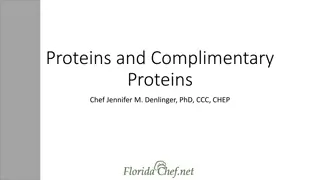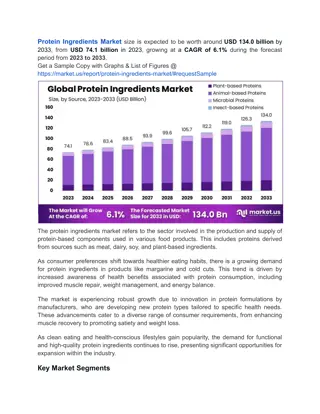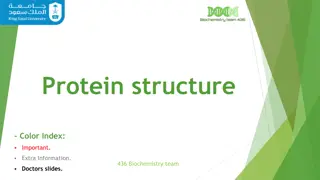Understanding Interferons: Proteins with Powerful Antiviral Properties
Interferons are naturally occurring proteins secreted by cells in response to viral infections and tumors. They play a crucial role in inhibiting viral replication and have shown clinical benefits in treating various diseases. There are different types of interferons, with Type I interferons like alpha and beta being essential in mobilizing the body's defense against invading organisms. Understanding the actions and types of interferons sheds light on their significance in immune responses and disease treatments.
Download Presentation

Please find below an Image/Link to download the presentation.
The content on the website is provided AS IS for your information and personal use only. It may not be sold, licensed, or shared on other websites without obtaining consent from the author. Download presentation by click this link. If you encounter any issues during the download, it is possible that the publisher has removed the file from their server.
E N D
Presentation Transcript
Discovery of Interferons 1957 Isaacs and Lindenmann Did an experiment using chicken cell cultures Found a substance that interfered with viral replication and was therefore named interferon
What are Interferons? Naturally occurring proteins and glycoproteins Secreted by eukaryotic cells in response to viral infections, tumors, and other biological inducers Produce clinical benefits for disease states such as hepatitis, various cancers, multiple sclerosis, and many other diseases Strucurally, they are part of the helical cytokine family which are characterized by an amino acid chain that is 145- 166 amino acids long
General Action of Interferons Interferons are small proteins released by macrophages, lymphocytes, and tissue cells infected with a virus. When a tissue cell is infected by a virus, it releases interferon. Interferon will diffuse to the surrounding cells. When it binds to receptors on the surface of those adjacent cells, they begin the production of a protein that prevents the synthesis of viral proteins. This prevents the spread of the virus throughout the body. Two types of interferons: TYPE1 AND TYPE 2
Type I Interferons Type I: alpha and beta Alpha interferons are produced by leukocytes Beta interferons are produced by fibroblasts Both bind to interferon cell receptors type 1 and both encoded on chromosome 9 They have different binding affinities but similar biological effects Viral infection is the stimulus for alpha and beta expression Used to mobilize our 1st line of defense against invading organisms Largest group and are secreted by almost all cell types
Type 1 interferon Interferons- alpha & beta Acid stable 14 interferon alpha genes and 1 interferon beta gene Act by binding a common interferon- alpha/beta receptor Type 2 interferon Interferon gamma Acid liable 1 interferon gamma gene Acts by binding an interferon- gamma receptor Encoded by ch no 9 12 Produced by almost all types of cells (alpha-majorly by leukocytes and beta by fibroblasts) Immune cells T cells, NK cells, B c cells, APCs Induce antiviral state, upregulate MHC- I Immune modulator, upregulates MHC-I and II expression and CMI response Immune and inflamatory stimuli Stimuli- viral infection
Type II Interferon (gamma) Bind to type 2 receptors and its genes are encoded on chromosome 12 Initially believed that T helper cell type 1 lymphocytes, cytotoxic lymphocytes and natural killer cells only produced IFNg, now evidence that B cells, natural killer T cells and professional antigen-presenting cells secrete IFNg also. Gamma production follows activation with immune and inflammatory stimuli rather than viral infection. its production is controlled by cytokines interleukin 12 and 18.
Interferon gamma is also called the immune interferon .it is produced by activated T-cells or natural killer cells.INF gamma promotes inflammation an upregulates MHC class1 and class 2 molecules. It is unstable at pH 2. It is advantageous during host cell infections when the virus switches off the RNA and protein synthesis so that IFN and IFN are prevented from being made. IFN appears either late in the infection or stimulation of the immune system
Mode of action of interferon The mode of action of interferon can be divided into two stages: (i) induction which results in release of interferon and (ii) anti viral state production in other cells by the released interferon.
INDUCTION STAGE Induction of interferon in human cells is controlled by chromosome 9 All multiplying viruses induce interferon and is believed that double stranded (ds) RNA is the specific inducer. Free interferon initiates an anti viral state in other cells by binding to a receptor on their cell surface.
ANTI-VIRAL STAGE The second stage represents the creation of an anti viral state in the neighbouring cells by the released intrferon binding to the interferon specific receptor on their cell surface. In man, chromosome 21 is required and perhaps codes for the synthesis of interferon receptor molecules. The anti-viral state has two modes of action ds RNA in the presence of interferon induced anti viral state stimulates the phosphorylation of certain cellular proteins resulting in - (i) impairs their function in the initiation of protein synthesis, (ii) ds RNA activates a ribonuclease which degrades mRNA and hence also stops protein synthesis.
Interferon as a drug Interferon was scarce and expensive until 1980 when the interferon gene was inserted into the bacteria using recombinant DNA technology allowing mass cultivation and purification from bacterial cultures. Can also be commercially produced using yeast
APPLICATIONS AND PHARMACEUTICAL USES USED IN COMBINATION WITH CHEMOTHERAPY AND RADIATION AS A TREATMENT FOR CANCERS. TREATMENT AND CONTROL OF MULTIPLE SCLEROSIS. PEGYLATED INTERFERON IN COMBINATION WITH THE ANTIVIRAL DRUG RIBAVIRIN IS USED IN TREATMENT OF HEPATITIS C.
PREVENTION AND TREATMENT OF VIRAL RESPIRATORY DISEASES SUCH AS COLD AND FLU. EFFECTIVE AGAINST TUMORS LIKE MELANOMA AND KAPOSI S SARCOMA.
SIDE EFFECTS OF INTERFERONS SIDE EFFECTS OF INTERFERONS Common side effects include:- 1. Fever 2. Fatigue 3. Muscular pains 4. Local inflammation 5. Convulsions, Dizziness, Hair thinning, Erythema High levels of interferons can cause kidney, liver, bone marrow and heart toxicity Interferon therapy is only effective if started before the virus is inoculated and is thus not applicable to natural viral infections
ROUTE OF ADMINISTRATION IFN and IFN are mostly administered by an intramuscular injection. The injection of interferons in the muscle and in veins or under the skin is generally well tolerated.
Different Interferon Drugs Interferons are broken down into recombinant versions of a specific interferon subtype and purified blends of natural human interferon. Many of these are in clinical use and are given intramuscularly or subcutaneously Recombinant forms of alpha interferon include: Alpha-2a drug name Roferon Alpha-2b drug name Intron A Alpha-n1 drug name Wellferon Alpha-n3 drug name AlferonN Alpha-con1 drug name Infergen Recombinant forms of beta interferon include: Beta-1a drug name Avonex Beta-1b drug name Betaseron Recombinant forms of gamma interferon include: Gamma-1b drug name Acimmune
Receptor for interferons in vaccinia virus and inhibits the interferons ability to function H5N1 influeza virus known to cause bird flu has resistance to interferons and other cytokines due to a single amino acid mutation in its non-structural protein(NS1) .this is the reason for its high mortality rates.
Conclusion Interferons have overlapping but different biological activities Their mechanisms of action are not fully understood, therefore there is a lot of room for future growth within this field Interferon based strategies can possibly be further tailored to each individual patient according to early response dynamics Other immuno modulators that are being tested include: Zadaxin and Ceplene
Viral resistance to interferons Some viruses have manifested methods that give them a way around interferons \ response. Methods- Inhibition of interferon signalling and production Blocking of the function of interferon induced proteins Japanese encephalitis virus blocks the interferon signalling. Pox viruses encode a soluble interferon receptor homologue that acts as a decoy to inhibit the biological activity of interferons eg-BI8R protein acts as a























